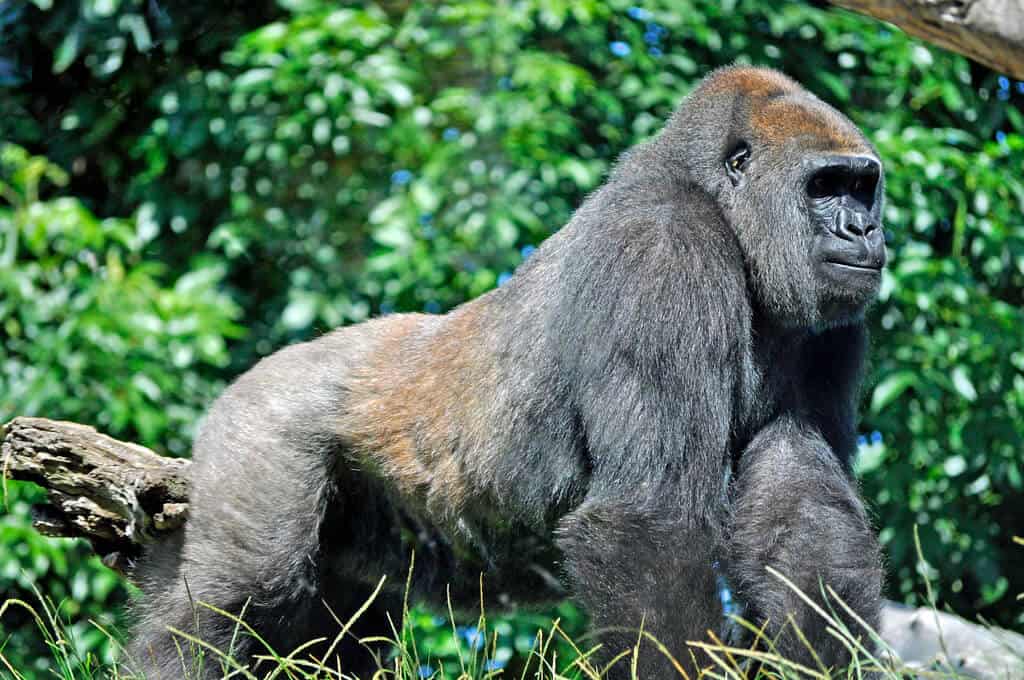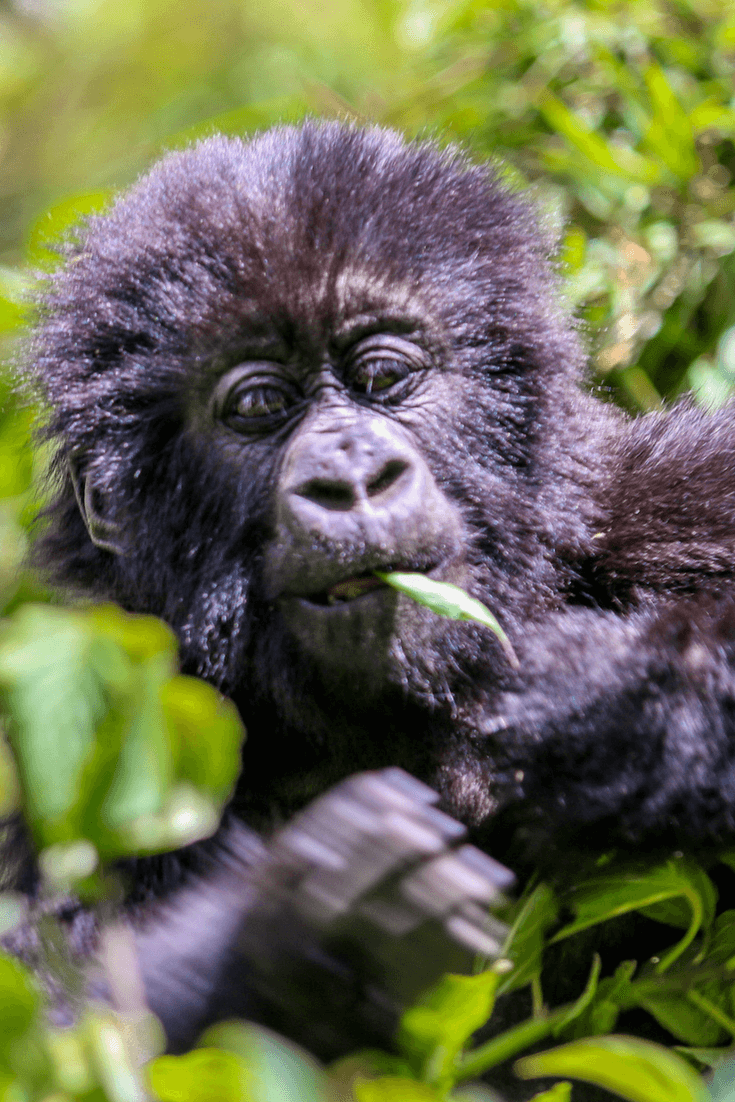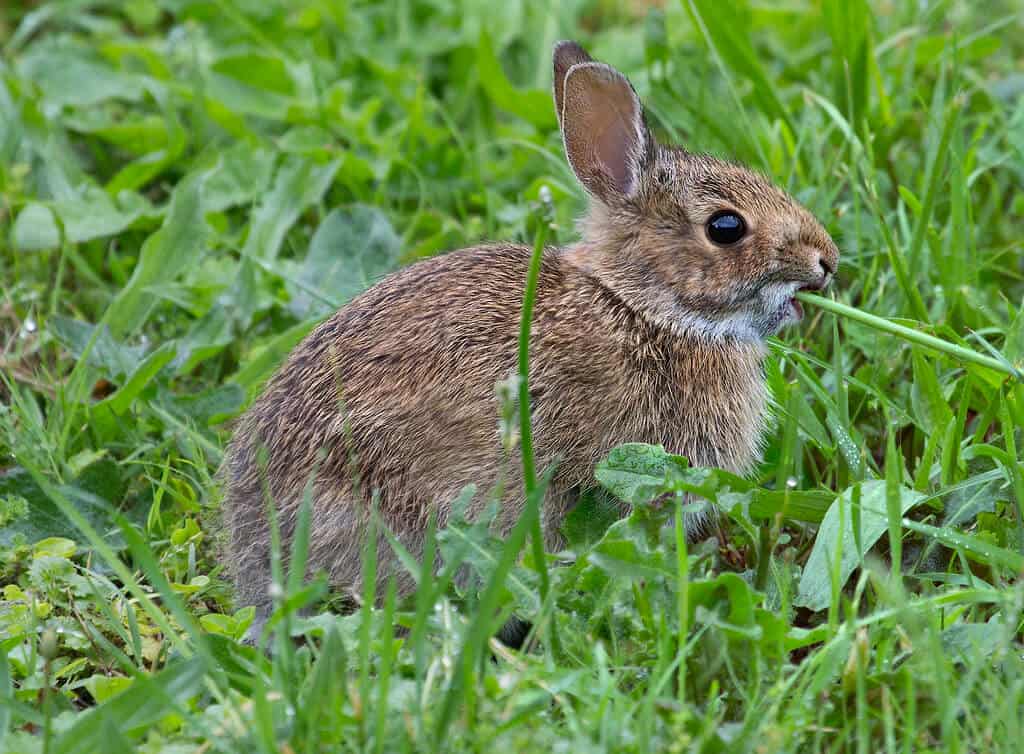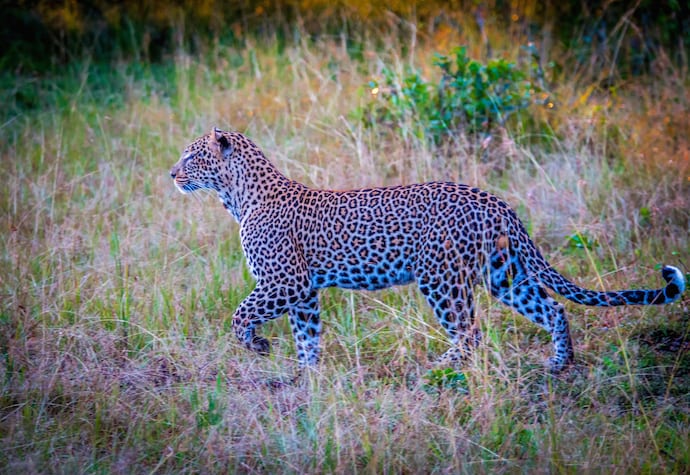[ad_1]
For most people, getting to see African wildlife such as the Black Rhino roaming along a vast open savanna in South Africa, or Mountain Gorillas high in the mountains of Uganda, is a once-in-a- lifetime opportunity.
Unfortunately, due to human encroachment, poaching, habitat fragmentation, and other reasons, many of these incredible species have become endangered.
In order to fully appreciate the breathtaking opportunity of getting to see these fascinating animals up close, we should first be conscious of their importance and their struggle for survival.
So here’s a look at some of the most incredible endangered African animals you can see on a safari, and why their populations have been in decline.
READ MORE: The 20 Safest Countries in Africa to Visit
ENDANGERED AFRICAN ANIMALS

1. African Penguin
Latin Name: Spheniscus demersus
Habitat: Southwestern coast of Africa from Namibia to Port Elizabeth and offshore islands
Size: Length: 24 to 28 in; Weight: 4.9 to 7.7 pounds
Diet: Anchovies, horse mackerel, pilchards, round herrings
Current Population: 50,000 mature individuals
When most people think of penguins, they usually imagine frigid polar habitats. But the African Penguin is uniquely equipped to cope with the high temperatures in South Africa.
When they start to get hot, blood is sent to a small pink gland above each of their eyes. It is then cooled by the surrounding air, regulating the animal’s temperature.
These cute creatures are also known for an array of black flecks on their white chest, which are individual to each penguin (much like a human’s fingerprint).
Unfortunately, the African Penguin is one of the most endangered types of penguin in the world. Their populations have declined by nearly 90% since the turn of the 20thcentury.
This decline can be largely attributed to industrial fishing, which depletes the African Penguin’s habitats of the fish they eat for food.
READ MORE: Penguins of Antarctica (Photo Gallery)

2. African Wild Dog
Latin Name: Lycaon pictus
Habitat: Arid zones in the savanna, woodland, and scrubland
Size: Length: 2.33 to 3.66 feet; Height: 2 to 2.5 feet; Weight: 40 to 79 pounds
Diet: Warthogs, antelope, rodents, birds, lizards, insects
Current Population: 1,409 mature individuals
The African Wild Dog is not only one of the most endangered animals in Africa, but also one of the most endangered mammals in the world. This is largely due to decades of habitat fragmentation, infectious diseases, and both accidental and targeted killings by humans.
Once ranging throughout Africa, their geographic range has shrunk to the savannas, woodlands, and scrublands of sub-Saharan Africa. The highest populations reside in Tanzania and northern Mozambique.
Incredibly social and family oriented, these spotted wild dogs are known to share food amongst their pack and assist with injured or sick members.
African Wild Dogs also hunt together and have an 80% success rate, making them one of the continent’s most highly effective predators.
READ MORE: Top 10 Tanzania National Parks & Reserves (The Ultimate Tanzania Safari)

3. Black Rhino
Latin Name: Diceros bicornis
Habitat: Savanna, shrubland, desert
Size: Length: 9.2 to 12 feet; Height: 4.5 to 6 feet; Weight: 1,800 to 3,100 pounds
Diet: Leaves, fruit, bushes
Current Population: 3,142 mature individuals
Black Rhinos are one of the oldest groups of mammals on the planet. But they have been driven to the IUCN endangered species list in large part by illegal poaching.
These magnificent animals sport two horns that are often used to protect their young. Unfortunately, they’re also often the reason Black Rhinos are killed. Their horns are used in traditional Chinese medicine and for ornamental purposes to display wealth.
African Black Rhinos can be distinguished from African White Rhinos, whose populations are also vulnerable, not by their color (they’re actually both grey) but by their upper lips.
Black Rhinos have a pointed upper lip to help pluck leaves and fruit from branches of trees, whereas White Rhinos have a squared lip that allows them to get closer to the ground to graze.
READ MORE: Animals in Kenya: A Guide to 40 Species of Kenyan Wildlife

4. Cheetah
Latin Name: Acinonyx jubatus
Habitat: Savanna, shrubland, desert, grassland
Size: Length: 3.6 to 4.9 feet; Height: 2.33 to 2.91; Weight: 46 to 160 pounds
Diet: Gazelles, impalas, springbok, duiker, warthogs, rabbits, antelopes
Current Population: 6,674 mature individuals
Famous for being the fastest land animal, Cheetahs can go from 0 to 60 mph in just three seconds and can reach peak speeds of up to 70 or 80 mph!
Their flexible spine, long legs, narrow frame, and specialized muscles make them uniquely adapted to reach such impressive speeds. They also have large nostrils, which allow them to inhale an increased amount of oxygen.
Although they’re undoubtedly an incredible species, Cheetahs are among the endangered big cats in Africa. They’re particularly vulnerable due to their limited genetic diversity, which makes them more susceptible to disease.
This combined with habitat loss from human expansion, illegal poaching, and wildlife trafficking have resulted in a stark decline in Cheetah populations.
READ MORE: The 25 Best National Parks in Africa for Wildlife Safaris

5. Chimpanzee
Latin Name: Pan troglodytes
Habitat: Tropical rainforest, savanna woodlands
Size: Length: 2.1 to 3.1 feet; Height: 3.3 to 4.9 feet; Weight 88 to 130 pounds
Diet: Seeds, leaves, fruit, bark, insects, flowers, small animals
Current Population: Between 150,000 and 250,000 in the wild
One of the most beloved endangered African animals, Chimpanzees are highly social apes that live in communities of up to 120 individuals, all led by an alpha male.
They’re incredibly intelligent, communicating through a complex system of body movements, vocalizations, and gestures. They’re also one of the few animal species we know of that use tools.
Humans share more than 98% of our genetic blueprint with Chimpanzees, but we’re also the main factor in why Chimp populations have declined.
Mining, oil extraction, deforestation, and highway projects have all pushed Chimpanzees out of their habitats, making it difficult for them to find food and alternate places to live.
Fortunately, legendary primatologist Jane Goodall and a variety of wildlife conservation organizations are actively working to expand protected areas for Chimpanzees.
READ MORE: Top 15 Female Wildlife Conservationists & Animal Rights Activists

6. East African Oryx
Latin Name: Oryx beisa
Habitat: Semi-deserts, brush savannas, steppes
Size: Height: 3.75 to 4.16 feet; Weight: 395 to 530 pounds
Diet: Grass, leaves, fruit, buds
Current Population: 11,000 to 13,000 mature individuals
Found in Ethiopia, South Sudan, and parts of Tanzania and Kenya, the East African Oryx has a grey coat and white underside, with distinctive black stripes along the nose, head, and belly.
Living in herds of around 5 to 40 individuals, they’re social animals who tend to travel with females at the front of the tribe and a larger male who guards the rear.
Although they will usually run when faced with danger, the two prominent horns that grow out of the East African Oryx’s head can be used to defend themselves (and are very effective in doing so).
The main threats to these African antelope are competition with livestock, being hunted for their meat and hides, and human settlement in their habitat.
READ MORE: Maasai Mara Conservancies: Community-Based Conservation in Kenya

7. Eastern & Western Lowland Gorilla
Latin Name: Eastern: Gorilla beringei; Western: Gorilla gorilla
Habitat: Eastern: Lowland tropical rainforests; Western: lowland forests of central Africa
Size: Eastern: Height: 5.2 to 5.4 feet; Weight: 179 to 359 pounds; Western: Height: 4.5 to 5 feet; Weight; 150 to 300 pounds
Diet: Pith, shoots, leaves, fruits, bark
Current Population: Eastern: 2,600; Western: 100,000
The Eastern and Western Lowland Gorilla are both endangered species in Africa that are highly intelligent, but are facing grave declines in population size.
The two species can be distinguished by their size. The Eastern Lowland Gorilla, which is also known as Grauer’s Gorilla, is a good bit larger and has a stockier body, with a short muzzle.
Both of these intelligent African animals have been seriously affected by poaching, disease, and habitat loss, resulting in a dramatic decrease in their populations over the last few decades.
READ MORE: 50 Interesting Facts About Gorillas

8. Ethiopian Wolf
Latin Name: Canis simensis
Habitat: Shrubland, grassland, inland cliffs, mountain peaks
Size: Length: 3 feet; Height: 2 feet; Weight: 25 to 43 pounds
Diet: Grass rats, hares, hyraxes, antelope calves
Current Population: 197 mature individuals
Found in only six mountain ranges across Ethiopia (the largest population lives in Bale Mountains National Park), Ethiopian Wolves are by far one of the most endangered animals in Africa.
They are highly social animals, usually living in packs of 6 members that are very hierarchical, with certain individuals being more dominant and others more submissive.
To establish who is more dominant in the pack, wolf pups will often play fight during the first few weeks after birth to establish their ranks.
They’re threatened in large part by humans. Subsistence farming in the highlands has taken over large sections of Ethiopian Wolves’ habitat, pushing them into smaller area and higher altitudes.
Disease has also played a factor in their population decline, with many of the animals falling victim to rabies and canine distemper.
READ MORE: 5 Endangered Species that Mate For Life

9. Grevy’s Zebra
Latin Name: Equus grevyi
Habitat: Semi-arid shrubland and grasslands
Size: Length: 7.5 feet; Height: 4 to 5 feet; Weight: 770 to 950
Diet: Grass, bark, leaves, fruit
Current Population: 1,956 mature individuals
The world’s largest wild equine, the Grevy’s Zebra is famous for the prominent narrow stripes that run across their coat, brown muzzle, and large round ears.
This African Zebra is different from other Zebra species because they don’t always form permanent herds.
Females and their young will live together, occasionally combining with other female and foal groupings. But males will usually live alone or join a bachelor herd.
Of all the African mammals, Grevy’s Zebras have dealt with the most drastic range reductions, which is the main cause of their declining populations.
These beautiful animals are also illegally hunted for their unique skins, or for food and medicinal uses. This, along with drought and disease, has also factored into their endangered species status.
READ MORE: Meru National Park, Kenya: From Joy Adamson to Elsa’s Kopje

10. Hooded Vulture
Latin Name: Necrosyrtes monachus
Habitat: Open plains, savannas, forests, coastal areas
Size: Length: 24 to 28 in; Weight: 3.3 to 5.7 pounds
Diet: Animal Carcasses, mussels, mollusks, dead fish, grasshoppers, grubs
Current Population: 197,000 mature individuals
The Hooded Vulture’s Latin name, Necrosytes monachus, means “monk-like (bird) that drags away the dead.” But African locals will often call them “garbage collectors.”
These peculiar endangered birds are world-class scavengers. Due to their smaller size, they can rise on air thermals quickly to find dead animal carcasses for their next meal.
Although quite shy by nature, Hooded Vultures will occasionally approach humans. In fact, one interesting way they find food is to follow a plow and collect the insects and larvae as they’re dug up.
Once widespread across sub-Saharan Africa, Hooded Vulture populations have faced a sharp decline due to carcass poisoning, an increase in trade for medicinal uses, hunting, and habitat loss.
READ MORE: Galapagos Birds: 25 Species You Can See on a Galapagos Cruise

11. Lemur
Latin Name: Lemuroidea
Habitat: Dry deciduous forests, spiny forests, rainforests, mountains, and wetlands of Madagascar and the Comoro Islands
Size: Length: 15 to 28 inches; Weight: 4.9 to 19 pounds
Diet: Fruit, insects, leaves, flowers, nectar, bark, shoots, sap
Current Population: Data Deficient
These animals native to Africa can only be found on the island nation of Madagascar, one of the most biodiverse places on the planet. Unfortunately, they’re teetering on the brink of extinction.
Of the 103 known lemur species, 91% of them are threatened, with 75% of those listed as endangered or critically endangered (like the Bamboo Lemur). So they’re the most endangered primates in the world.
These intriguing creatures have been the victim of increased commercial hunting, plus widespread habitat destruction from illegal logging, mining, and slash-and-burn agriculture.
To help combat these factors, the IUCN has enacted an action plan to help revitalize Lemur populations by protecting their habitats and using ecotourism to steer local people away from hunting the animals.
READ MORE: Madagascar Animals Photo Gallery

12. Mountain Gorilla
Latin Name: Gorilla beringei beringei
Habitat: Mountainous forests in the Democratic Republic of Congo, Rwanda, and Uganda’s Bwindi Impenetrable Forest National Park
Size: Height: 4 to 6 feet; Weight: 300 to 485 pounds
Diet: Leaves, roots, stems, bark, shoots, flowers, fruit,
Current Population: 1,000 mature individuals
Mountain Gorillas live high in the mountains at elevations between 8,000 and 13,000 feet. They have thicker and longer hair than their lowland cousins, which keeps them warm in colder temperatures.
They gather in communities of up to 30 individuals, organized in a social structure led by a dominant older male. They’re known as Silverbacks because of the swatch of silver-colored hair along their backs.
Living predominately in areas historically plagued by sociopolitical violence, these African gorillas suffered the consequences. This combined with habitat loss from agriculture, deforestation, illegal mining, poaching, and climate change have seriously affected their populations.
At one point the outlook for these gentle giants was grim. But in recent years, thanks to conservation efforts and Gorilla trekking tourism, Mountain Gorilla populations have been slowly increasing.
READ MORE: Mountain Gorilla Trekking in Rwanda (with Dian Fossey’s Porter)

13. Pangolin
Latin Name: Pholidota
Habitat: Tropical forests, thick brush, savannah, grassland
Size: Length: 12 to 39 in; Weight: 3.5 to 73 pounds
Diet: Ant, termite, larvae, insects
Current Population: Data Deficient
Often mistaken for reptiles due to their scaly appearance, these unique animals are actually mammals.
There are eight species of Pangolins, four of which can be found in Asia. The remaining four– the Ground Pangolin, Giant Pangolin, White-bellied, and Black-bellied Pangolin– are all African wildlife species, and are all endangered.
The primary reason is large-scale trafficking to Asia. This is fueled by the traditional medicine belief that their scales have curative properties, and their meat is considered a delicacy.
It’s estimated that over 10,000 Pangolins are illegally trafficked each year, making it the world’s most trafficked non-human mammal. More than one million Pangolins have been poached in the past decade.
READ MORE: 70 Cool & Weird Animals Around the World

14. Pygmy Hippopotamus
Latin Name: Choeropsis liberiensis
Habitat: Forest, savanna, inland wetlands, swamps
Size: Length: 4.92 to 5.74 feet; Height: 2.46 to 3.28 feet; Weight: 397 to 606 pounds
Diet: Ferns, broad-leaved plants, fruits, leaves
Current Population: 2,000 – 2,499 mature individuals
The Pygmy Hippopotamus may fool you with their shy demeanor and smaller size compared to their relative- the common Hippopotamus (whose populations are classified as vulnerable). But it’s actually the deadliest animal in Africa.
In fact, the only known animals that live in Africa that are natural predators of Pygmy Hippos are Leopards. Other African wildlife catch a glimpse of their large teeth and tusks and know to stay away.
Despite being ranked as the most dangerous animal in Africa, Pygmy Hippos have also suffered at the hands of humans.
Many are hunted for their meat, or forced out of their homes from rivers being polluted and forests being cut or burned down.
READ MORE: How to Get the Most for Your Kruger National Park Entrance Fee

15. Riverine Rabbit
Latin Name: Bunolagus monticularis
Habitat: Shrubland
Size: Length: 13.26 to 18.47 inches; Weight: 2.2 to 3.3 pounds
Diet: Flowers, leaves, shrubs, grasses,
Current Population: 157 to 207
The Riverine Rabbit is one of Africa’s most endangered animals after suffering the loss of virtually all of their habitat to cultivation and livestock farming.
These adorable animals are the only indigenous burrowing rabbit in Africa. They depend on the deep soils and bush along the seasonal rivers of central Karoo (a semi-desert in South Africa) to survive.
Because they only produce one baby at a time in their burrows, these cute creatures have a slow population growth rate. Threats from hunting and getting caught in traps on farmland have not helped.
The good news is that the Riverine Rabbit was recently discovered in the Sanbona Wildlife Reserve and Vaalkoof Private Nature Reserve, which serve as a hopeful sign for the species’ survival.
READ MORE: My Life Changing Experience in South Africa

16. Rothschild’s Giraffe
Latin Name: Giraffa Camelopardalis
Habitat: Savanna plains, desert
Size: Height: 16 to 19 feet; Weight: 1,800 to 2,500 pounds
Diet: Acacia and wild apricot leaves, sprouts, fruits
Current Population: 1,669 in the wild
One of the more recognizable endangered species in Africa, Rothschild’s Giraffe is one of the tallest subspecies of Giraffe, reaching heights of up to 19 feet!
These incredible animals live in small herds in Kenya and Uganda. But their populations have been adversely affected by agricultural developments, poaching, and the degradation of their habitat.
The few Rothschild’s Giraffes that are left are mostly confined to protected areas and are isolated from each other, making interbreeding and population growth difficult.
Conservation efforts, including the launch of a National Giraffe Conservation Strategy by the Kenya Wildlife Service, are working to preserve these African savanna animals’ populations and bring awareness to the efforts needed to support their survival.
READ MORE: 50 Fascinating facts about Giraffes
VULNERABLE AFRICAN ANIMALS

African Elephant
Latin Name: Loxodonta africana
Habitat: Rainforest, scrub forests, savanna, grassland, desert, wetlands
Size: Height: 8.2 to 13 feet; Weight: 2.5 to 7 tons
Diet: Roots, grasses, bark, fruit
Current Population: 415,000
African Elephants are the largest land animals on Earth. They’re considered a keystone species, meaning their existence is vital to the health of their ecosystem.
For example, during the dry season they use their massive tusks to dig riverbeds and create water holes for other animals. And when they dine on trees in the forest, they create channels for smaller animals to weave through.
The biggest threat these magnificent animals face (on top of already low reproduction rates) is poaching for the ivory trade. At one point between 1970 and 1990, it even put the African Elephant at risk of extinction.
They’re also losing large swaths habitat to farmland, making it difficult for them to find food and water.
Thankfully, African Elephants are granted certain protections. Efforts have been made to re-legalize the international ivory trade, but they have been unsuccessful so far.
READ MORE: 55 Interesting Facts about Elephants

African Lion
Latin Name: Panthera leo
Habitat: Forest, savanna, grassland, open woodland
Size: Length: 4.6 to 8.2 feet; Weight: 330 to 550 pounds
Diet: Antelopes, zebras, rhinos, hippos, crocodiles, giraffes, hares, wild hogs
Current Population: 23,000 to 39,000 mature individuals
With their royal mane, powerful build, and a deafening roar that can be heard up to five miles away, it’s no wonder the African Lion is known as the “King of the Jungle.”
Once roaming across most of Africa and into sections of Asia and Europe, these increasingly endangered big cats only inhabit 6% of their historic range. They’re now isolated to sub-Saharan Africa.
This decrease in a once-plentiful population can be attributed to a variety of problems, the greatest of which is that their habitats are being converted to human settlements, roads, and farmland.
As a result, African Lions are being forced into closer proximity with humans. This limits their food supply and leads to livestock attacks, and ultimately being killed by farmers protecting their herds.
They also face the threat of poaching as a highly sought-after hunting trophy. Some people in Asia even believe that certain body parts of this maginificent creature have medicinal powers.
READ MORE: The Connection Between Walking With Lions & Canned Lion Hunting

Great White Shark
Latin Name: Carcharodon carcharias
Habitat: Coastal waters throughout the world
Size: Length: 11 to 21 feet; Weight: 1,200 to 2,400 pounds
Diet: Sea lions, seals, fish, dolphins, porpoises, sea turtles, sea otters
Current Population: Data Deficient
Widely considered the most fearsome predators in the sea, the Great White Shark is actually not as big of a threat to humans as we’re led to believe. In fact, only 1/3 to 1/2 of all shark attacks each year are by this particular species.
Though their danger to humans may be over-hyped, Great White Sharks are the world’s largest predatory fish and are incredibly skilled at hunting their prey.
Their mouths are filled with rows of some 300 serrated teeth, and they can sense small electromagnetic fields created by animals that help lead them to their next meal.
Despite their fierce skill set, the Great White Shark population has been in decline after being hunted for their fins and teeth for years. They are also often caught in gill nets from commercial fisheries.
Many conservationists believe that a long-line fishery off the coast of South Africa plays a big role in their decline by targeting small species of sharks that are a common prey for Great Whites.
READ MORE: 5 Rare Sharks Worth Saving

Leopard
Latin Name: Panthera pardus
Habitat: Rainforests, deserts, woodlands, forests, grassland, savanna
Size: Length: 3 to 5.4 feet; Weight: 51 to 68 pounds
Diet: Baboons, rodents, monkeys, snakes, large birds, fish, antelopes
Current Population: 12,000 to 14,000
Known for their striking spotted bodies, Leopards are the most adaptable of the African big cats and can live in a variety of habitats.
They are incredibly skilled hunters, and will often hunt from the cover of trees. They use their spotted bodies to blend in with the leaves, then pounce on unassuming prey.
Unfortunately, an estimated 66% of the Leopard’s natural range in Africa has been taken over by humans through various expansion and agricultural projects.
Leopards are also commonly hunted for their skins and teeth, which has contributed to their population decline. –by Christina Maggitas; lead photo via Canva
[ad_2]






